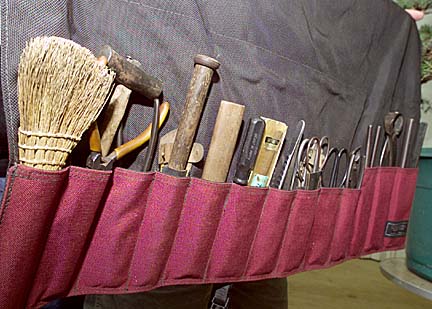


In The Garden![]()
Friday, August 24, 2001

GEORGE F. LEE / GLEE@STARBULLETIN.COM
Bonsai Masters Kenji Miyata, left, of Toyohashi
City, Japan, and Tohru Suzuki of Okazaki City,
Japan, show off their tools.
The 50-plus-year-old juniper isn't quite yet the perfect bonsai specimen. It still has years to be go before the branches are properly trained and the needle-like leaves grow green and full. But for a tree once designated for the garbage, it is doing remarkably well thanks to a group of Honolulu bonsai devotees and two bonsai masters from Japan. Japanese masters
shape 50-year-old
juniper into bonsaiThe juniper belonged to Helen Horikawa, a member of the Hawaii Bonsai Association. Her son, Michael, said the tree most likely came from his grandfather on Kauai, and it was in his mother's yard in Kuliouou for 35 years. Three years ago, the tree was dug up to make way for the family home expansion and it almost got tossed in the garbage.
"But my mother said we should save it. It didn't look like much but maybe somebody would want it," he said.

Alvin Chang, another bonsai association member, saw the tree's potential and took it home. He potted it and nursed it, waiting for the right time to begin the transformation.The state Farm Fair last weekend offered the perfect opportunity. The association had invited bonsai masters, Kenji Miyata and Tohru Suzuki, from Nagoya to give demonstrations at the fair, and they needed something to work with.
The 4-foot-tall tree with a horizontal span of about 7 feet was the ideal model to show off their mastery of the ancient Japanese art. Its size was impressive, and the undulating trunk with a couple of curvy branches in the middle provided added interests.
"As soon as Kenji looked at it, he said it was born to be a bonsai," said Ted Tsukiyama, who helped found the association 30 years ago.
For two-and-half hours, the two masters chopped, sawed, trimmed and ground away at the tree, reducing it to about half of its original size. They wired the branches and even attached a rebar to force downward curves to simulate the natural sweeps that in nature would be caused by years of heavy snow weighing down the branches.

To further give it the illusion of a tree hundreds of years old, the two created a weather-beaten swerve with the two curvy branches in the middle of the trunk."It's wave style -- natural," said Master Miyata, of the curvy sweep. (Miyata is a surfing enthusiast who regularly visits Hawaii for the waves and shares his knowledge with island bonsai club members.)
The two masters reshaped the branches and tapered the tips. Then they peeled away the bark to expose the wheat-colored wood beneath, making it seem as if that part of the tree had been struck by lightning and smoothed by the sun, wind and rain.
This aging technique is known as "jin," and it would have taken days to complete with traditional hand tools such as scalpels or very sharp grafting knives. But the two masters completed it in one night with electric tools.
"It was very impressive watching them work. It's the first time we had two masters together. The tent was packed. We had standing room only," Tsukiyama said.

Master Suzuki, through translation by Tsukiyama, said the tree still requires more shaping and training for two to four years before it becomes a true bonsai. They held back on the trimming to lessen the shock to the tree.In the next trimming, probably in the spring, the branches will take on the proper definitions. The roots also will be trimmed to allow them to fit into a traditional bonsai container. But for now the tree, which remains in the water bucket, needs to recoup from the trauma of severe trimming and shaping.
The original plan is to keep the tree undisturbed. It was to be kept at the home of the club president, Jane Yamashiroya, until it is well enough to be transported to its owner's home. But the masters have agreed to allow the tree to be displayed at the Okinawan Festival over the Labor Day weekend.
The tree will be on display with bonsai examples from the club's members. Master Miyata will be among the club members giving demonstrations.
Hawaii Bonsai Association
Where: Okinawan Festival at Kapiolani Park
Display & Demonstrations
When: 9 a.m. to 9 p.m. Sept. 1, 9 a.m. to 4 p.m. Sept. 2
Cost: Free
Call: 839-9910
Gardening Calendar
Suzanne Tswei's gardening column runs Saturdays in Today.
You can write her at the Star-Bulletin,
500 Ala Moana, Suite 7-210, Honolulu, HI, 96813
or email stswei@starbulletin.com